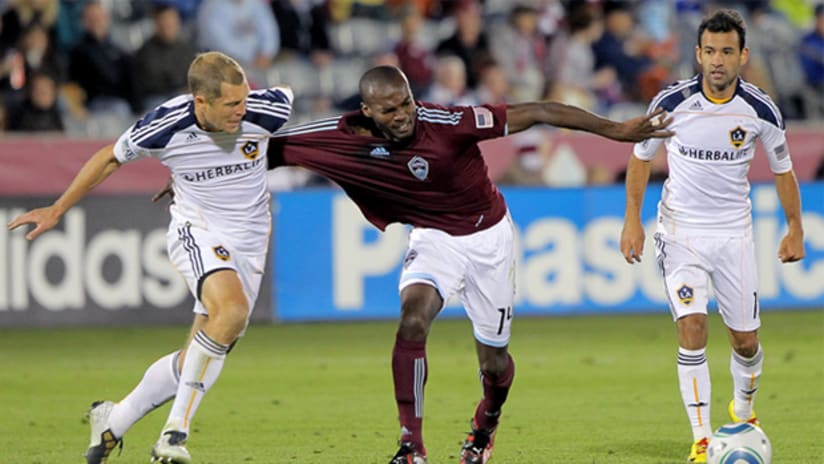It’s the LA Galaxy’s galaxy right now; the rest of MLS is just living in it.
Well, Columbus might argue the point, and a couple of others could say something about it eventually. But for now, no other team has presided so regally as Bruce Arena’s Galaxy. Through a third of the season, the side has hoarded 26 of a possible 30 points. A plus-14 goal difference is easily league best.
Clearly, high-level success is about more than tactics. It’s about chemistry, roster construction, player management, choices on the field, etc. But there is a chosen way forward.
First, no one is re-inventing the tactical wheel around the Home Depot Center with that 4-4-2 and a shifting midfield shape. They do what a lot of teams do—they just tend to be better at it, more disciplined about it and more committed to it all.
It starts with low-pressure tactics applied strategically, first by the pair of forwards. Generally, the Galaxy strikers aren’t chasing and harassing opposing defenders. Rather, they take up smart positions near the inside, looking to direct passes outside and then squeezing the game toward the sidelines from there.
As possession moves outside, the Galaxy wide midfielders initiate the pincers, working to “trap” players in possession toward the sideline, leading to turnovers.
At that point, the Galaxy are adept at transitioning pronto from defense into offense. Galaxy midfielders and outside backs have learned to quickly recognize these targeted moments of opportunity. Last week when LA visited Dallas, the possession change took place inside the Galaxy’s penalty area, and the reaction was ruthless.
In rapid succession, Chris Birchall, Chris Klein, rookie Tristan Bowen and Mike Magee combined to move the ball the length of the field in 12 seconds. (So, any notion that the Galaxy propensity to strike on counterattacks is all about Landon Donovan’s speed disappeared immediately; Donovan and Edson Buddle, of course, are away for now with the national team.)
When the Galaxy aren’t exploiting turnovers, they make things difficult through tight defense, which hinges on communication and information sharing. Hence, they’ve allowed just two goals through 10 matches, an MLS season-opening best.
LA recover into defensive shape as expeditiously as any team in MLS and then stay linked better than most. When the opposition gains possession, the center of the midfield shifts from a diamond shape, with Juninho at the top and Birchall at the bottom, into a flatter set-up, as Juninho drops in alongside his partner. The team’s basic defensive shape becomes two lines of four.
Behind the midfielders, you rarely see the back four stretched across the field. They are always compact. And the lines stay linked vertically as well. Generally, there are about 40 yards or less between the Galaxy strikers (remember, they set up in low pressure so they aren’t chasing way up the field) and the Galaxy back line. Center backs Gregg Berhalter and Omar Gonzalez and the LA fullbacks are so dependably well-coordinated that they can safely defend a little higher up the field. Other clubs may drop their line further back, not quite as confident about stepping forward and backward with such precision.
With the ball, the Galaxy aren’t doing anything new either. They make good choices and keep the ball moving with lots of one- and two-touch possession. It’s not exactly the toca-toca, slow-build South American game, but it does exploit one or two quick passes to establish possession and then look forward.
So they aren’t necessarily trying to wear down opponents with possession the way Real Salt Lake do. Rather, they want to limit costly turnovers in the defensive half of the field, preferring to let the other fellow make the killer mistakes in possession.
“You could tell in the first half, when we were playing good soccer, they were having trouble,” Birchall said of Thursday’s win. “It was only a little later when we were giving the ball away cheaply that they were able to get back in the game.”
Against Dallas, the Galaxy lined up two rookies and two second-year players (plus Juninho, who is just 21). But that wasn’t a problem. The Galaxy all seem to play within themselves, be they youngsters or vets. (Although Gonzalez has gotten more adventurous with his passing this year, and that’s an area of his game that needs more polish.)
In many others, the 2010 Galaxy team looks a lot like the 2000 Kansas City team that won the MLS Cup: a very good goalkeeper (Tony Meola for KC, Donovan Ricketts for LA), one prominent difference-maker on attack (Preki then, Donovan now), a productive striker (Miklos Molnar then, Buddle now) and a lot of role-filling guys in between. Current LA midfielder Chris Klein, who played for the Wizards then, said the Galaxy have greater depth and probably more talent, but that the teams were similar in their role recognition and tightly organized ways.
“That goes to having good soccer players,” Klein said. “It’s the experience we have [in L.A.] front to back, and it’s no secret the way Bruce has organized the team, and you see it in the results.”

